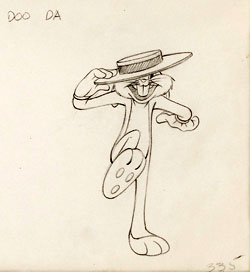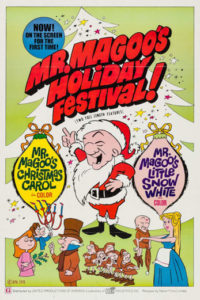Abe Levitow was an animator and director who worked with some of the biggest animation studios in Hollywood during the Golden Age.

A Levitow clean-up of a Ken Harris drawing from “Mississippi Hare”
Levitow returned to the studio, now known as Warner Bros. Cartoons. There, he worked as an assistant to animator Ken Harris in Chuck Jones’s unit. He married to Charlotte Winifred Lewis in December 1949 – she worked as a painter at the studio. The November 1950 issue of the studio house organ, Warners Club News, reported his promotion to full animator. However, he did not receive screen credit until Wild Over You, released 1953.
In the summer of 1953, Warner Bros. closed its animation department for a six-month period.
Abe returned to Warner Bros. when they opened in January 1954. Throughout his time with the studio, he worked as an animator on some of Chuck Jones’ classic films, such as Beanstalk Bunny, One Froggy Evening, Ali Baba Bunny, What’s Opera, Doc?, Robin Hood Daffy, and Hare-way to the Stars.
 Around 1956, Chuck became heavily involved with Gateways to the Mind, an educational science film sponsored by Bell Telephone System, and featuring Frank Baxter.
Around 1956, Chuck became heavily involved with Gateways to the Mind, an educational science film sponsored by Bell Telephone System, and featuring Frank Baxter.
Abe was enlisted take over Chuck’s unit during this period, being promoted to director. During this time he directed a trio of cartoons – A Witch’s Tangled Hare, Really Scent, and Unnatural History – each released 1959.
Abe was hired away by UPA to work as an animation director on the Magoo feature, 1001 Arabian Nights. He stayed with the studio after the loss of the Columbia contract directing shorts such as Magoo Meets Frankenstein and Magoo Meets McBoing Boing. Levitow remained at the studio as producer of the TV cartoons of Mr. Magoo and Dick Tracy.
 He freelanced at several studios as well during this time, sharing directorial credits with Chuck Jones at Warners on cartoons such as Baton Bunny, Lickety-Splat!, Nellie’s Folly, and Martian Through Georgia. He also contributed some memorable animation to the Jack Kinney Popeye TV pilot Barbeque For Two.
He freelanced at several studios as well during this time, sharing directorial credits with Chuck Jones at Warners on cartoons such as Baton Bunny, Lickety-Splat!, Nellie’s Folly, and Martian Through Georgia. He also contributed some memorable animation to the Jack Kinney Popeye TV pilot Barbeque For Two.
In 1962, Abe directed the NBC Christmas special Mr. Magoo’s Christmas Carol, the first animated Christmas special for television.
That same year, Abe directed the animated film Gay Purr-ee, starring Judy Garland and Robert Goulet. The film was the first animated film released by Warner Bros. and despite positive reviews, it was not a financial success.
During the mid to late 1960’s, Abe was director on several MGM Tom and Jerry short films such as Catty-Cornered, Surf Bored Cat, Guided Mouse-ille, The A-Tom-inable Snowman, and Puss N’ Boats.
 In 1970, Abe collaborated with Chuck Jones yet again to co- direct the film The Phantom Tollbooth, an adaptation of the children’s book by Norton Juster. In addition, Levitow contributed to Curiosity Shop (his spots were produced at Format Films), an educational television series for ABC executive produced by Jones. He directed segments directly based on adaptations of the comic strips B.C., Miss Peach, and The Wizard of Id.
In 1970, Abe collaborated with Chuck Jones yet again to co- direct the film The Phantom Tollbooth, an adaptation of the children’s book by Norton Juster. In addition, Levitow contributed to Curiosity Shop (his spots were produced at Format Films), an educational television series for ABC executive produced by Jones. He directed segments directly based on adaptations of the comic strips B.C., Miss Peach, and The Wizard of Id.
In 1972, Abe and producer Dave Hanson founded Levitow/Hanson Films. With that studio, Abe and Dave produced a few animated pieces for the children’s television series Sesame Street, most notably the environmental recurring segment Willie Wimple, which included a song written by Abe and Dave. Levitow/Hanson produced B.C. The First Thanksgiving, which aired November 1973. In 1975, he was intended as the director of Raggedy Ann and Andy: A Musical Adventure. During pre-production, he succumbed to bone cancer on May 9 at the age of fifty-two.
Below, a few clips attributed to Abe Levitow…


 Jerry Beck is a writer, animation producer, college professor and author of more than 15 books on animation history. He is a former studio exec with Nickelodeon Movies and Disney, and has written for The Hollywood Reporter and Variety. He has curated cartoons for DVD and blu-ray compilations and has lent his expertise to dozens of bonus documentaries and audio commentaries on such. Beck is currently on the faculty of Cal Arts in Valencia, UCLA in Westwood and Woodbury University in Burbank – teaching animation history. More about Jerry Beck [
Jerry Beck is a writer, animation producer, college professor and author of more than 15 books on animation history. He is a former studio exec with Nickelodeon Movies and Disney, and has written for The Hollywood Reporter and Variety. He has curated cartoons for DVD and blu-ray compilations and has lent his expertise to dozens of bonus documentaries and audio commentaries on such. Beck is currently on the faculty of Cal Arts in Valencia, UCLA in Westwood and Woodbury University in Burbank – teaching animation history. More about Jerry Beck [



































Thanks to all for today’s post on Abe Levitow. His name is one I always remembered seeing on opening and closing credits of cartoons seen theatrically and on TV as I was growing up. Nice to read an overview of his career.
I’m not sure that “educational” is the right word to describe “Curiosity Shop”. I remember it as a showcase for short animated films, hosted by three children and an assortment of puppets who popped out of a wall full of doors like the cast of “Laugh-In”. Some of these cartoons, like the comic strip adaptations mentioned here, were apparently pilots for Saturday morning series, but others were quite clever and sophisticated. I recall one that was in the form of an alien documentary about life on Earth, making the assumption that cars were the dominant form of intelligent life, and humans, mere parasites! I was very fond of the show and was quite surprised to find that Chuck Jones later disparaged it. I’d love to see it again, but doubt that I ever shall.
Sorry to learn that Abe Levitow died of bone cancer. That’s a terrible way to go. He had a hand in many of the great cartoons of the 20th century and deserves to be remembered here in his centennial year.
I believe the cartoon you described was “What on Earth” from the National Film Board of Canada. A classic.
Not all the animations were pilots, or even made for the show. Some were imports from Zagreb (with English voiceover added), and the one about martians thinking cars were Earth’s dominant life form is a classic from the National Film Board of Canada. I suspect it’s never been rerun because of the rights to those pre-existing shorts, not to mention the comic strips that were animated.
Thank you both! I just looked up “What on Earth” and saw it again for the first time in fifty years!
The issue with rights can be dufficult when it comes to outside acquisitions not original to the show.
Very nice overview of Abe Levitow’s career highlights. Well done.
Had he lived further he probably would’ve done more with Johnny Hart’s B.C. characters.
i remember that PSA for ACTION Corps (sort of an urban Peace Corps), with the jingle based on “A – You’re Adorable.” I think there was only one other animated adaptation of B.C.
Great read!
Why was Warner’s cartoon unit shut down for half of 1953?
More information about this can be found in books like Michael Barrier’s Hollywood Cartoons – but in a nutshell, the entire Warner Bros. studio stopped all film production as it was weighing the option to go all 3-D (which turned out to be a short-lived fad).
I heard Gay Purr-ee is the reason UPA quit the animation business and focused on Tokusatsu (primarily being the US manager of Godzilla) when Henry G. Saperstein stated upon the box office failure Gay Purr-ee that “Animation is dead” (his words, not mine)
He also worked on those animated sequences on SESAME STREET too.
https://muppet.fandom.com/wiki/Abe_Levitow
Along with all the other reasons to be grateful to Abe Levitow, I have a special one: In 1973 (I think), he spoke at Reed College and showed an amazing collection of cartoons—ones he worked on, of course, but also other treasures such as LITTLE RURAL RIDING HOOD. My father (who taught at Reed) took me, and we laughed our heads off. It was the first time I’d been exposed to a curated collection of great cartoons, and also the first time I’d seen someone associated with animation in person (with the possible exception of Disney composer George Bruns, who appeared at some sort of parade I attended at around the same time).
Just recently, over on Facebook, I learned from Levitow’s daughter Judy that his Reed appearance happened because she attended the school at the time. It was a thrill to learn more about this almost 50-year-old event that made such an impression on me and my dad.
A huge thank you to James Nobes (Nostalgia Talk), Devon Baxter, Mike Kazaleh and, of course, Jerry Beck. It was heartbreaking to lose our Dad far too soon, but we’re thrilled that he is still remembered and cherished by so many colleagues and fans. He LOVED being part of the animation community. We welcome you to check out the website we created (with enormous thanks to Darrell Van Citters & Matthew Clinton) to honor his memory : http://www.abelevitow.com.
It’s unfair to all concerned that cancer cheated Abe Levitow out of the long life that so many other animators had (many of them living up into their nineties, or at least late eighties).
Is the name pronounced with the accent on the second syllable or the third? I’ve heard both, which doesn’t surprise me (people can’t seem to make up their minds whether Leonard Bernstein’s name is pronounced “Bernstine” or “Bernsteen”).
I heard an interview with Judy Levitow that pronounced it “LEV-it-oh”, accent on the first syllable. As for Leonard Bernstein, “-stine” is correct. Classical radio stations always get it right, or else they’d be flooded with angry calls. On the other hand, film composer Elmer Bernstein (no relation) pronounced his surname “-steen”.
Incidentally, the failure of “Gay Purr-ee” can be attributed primarily to a lack of clarity regarding its target audience. It was too sophisticated for the kiddies, too twee for their parents, and kind of dull all around. Nicely done, though.